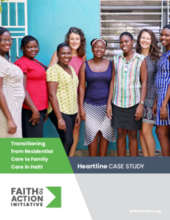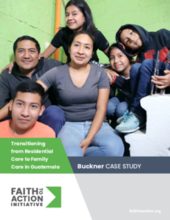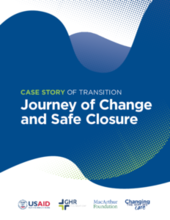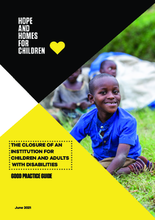The aim of this stage is to wind up the organisation registered for the purpose of running a residential care institution, settling any outstanding legal affairs and obligations, and distributing any assets in accordance with the organization’s constitution. This may occur in cases where the organization does not intention to run any services, initiatives or conduct any activities once the residential care institution has closed and where all cases will be referred to other organizations or government for monitoring and to access ongoing support.
This stage is concerned with closure or the legal entity and winding up its affairs.
Activities in this stage may include:
- Arranging for the safe transfer, sale or distribution of assets (based upon the articles of the organization’s constitute where one is in place)
- Dissolving and deregistering the entity and its legal board/s with the relevant government ministry/body
- Concluding partnership agreements with donors/partners
- Providing notice of dissolution of entity to relevant stakeholders such as donors
- Terminating services and any remaining contract (utilities, contractors, rental agreements etc.)
- Paying any outstanding bills
- Preparing redundancy packages for remaining staff and concluding employment contracts
- Conducting final audits, completing any final reporting requirements
- Closing bank accounts
- Providing final reports/documentation to relevant government authorities
- Concluding outstanding legal matters
Key milestones associated with this stage are:
- Legal entity has been formally dissolved and is no longer registered to operate
- All duties under law, regulation, contracts and agreements have been formally discharged
- All stakeholders including relevant authorities have been notified
- Closure has been documented
Resources
Displaying 1 - 5 of 5
The story of Heartline’s transition from residential care to family care is told in this recently released Faith to Action case study. The case study details their experience through three stages of transition—learning, preparation and planning, and full transition—with transparency. It addresses common challenges for transitioning organizations, as well as the strategies Heartline took to overcome them.
The story of Buckner Guatemala’s transition from residential care to family care is told in this recently released Faith to Action case study. The case study details their experience through three stages of transition—learning, preparation and planning, and full transition—with transparency. It addresses common challenges for transitioning organizations, as well as the strategies Buckner took to overcome them.
The Journey of Change and Safe Closure case story demonstrates the process of early engagement and awareness to supporting the long-term reintegration of children in families.
This COSP 15 side event was organised by ENIL, in cooperation with Disability Rights Defenders. It addressed the issue of increasing segregation of persons with disabilities in institutions as a result of the war in Ukraine, despite lessons learned during COVID. It focused on the role of the funders in the humanitarian response and the post-war recovery, urging for full compliance with the UN CRPD and ensuring that no funding goes towards institutionalisation of persons with disabilities.
This document outlines 5 key steps that serve as an effective blueprint for a successful reintegration process of children and disabilities. These include ‘engagement’, ‘Assessment’, ‘Design & Development’, ‘Transition’, and ‘Monitoring & Evaluation’.




